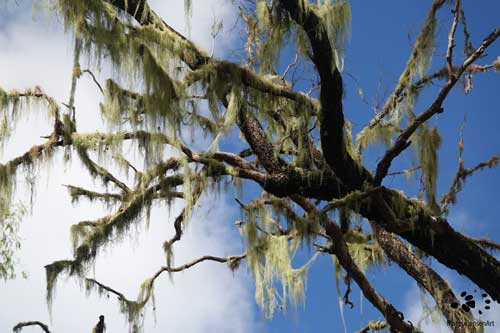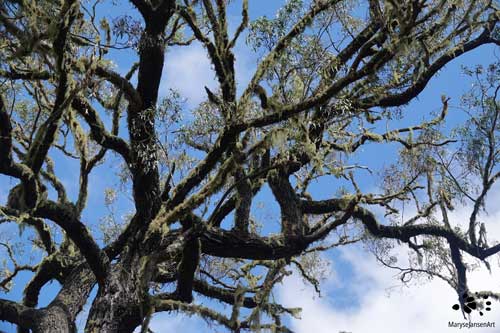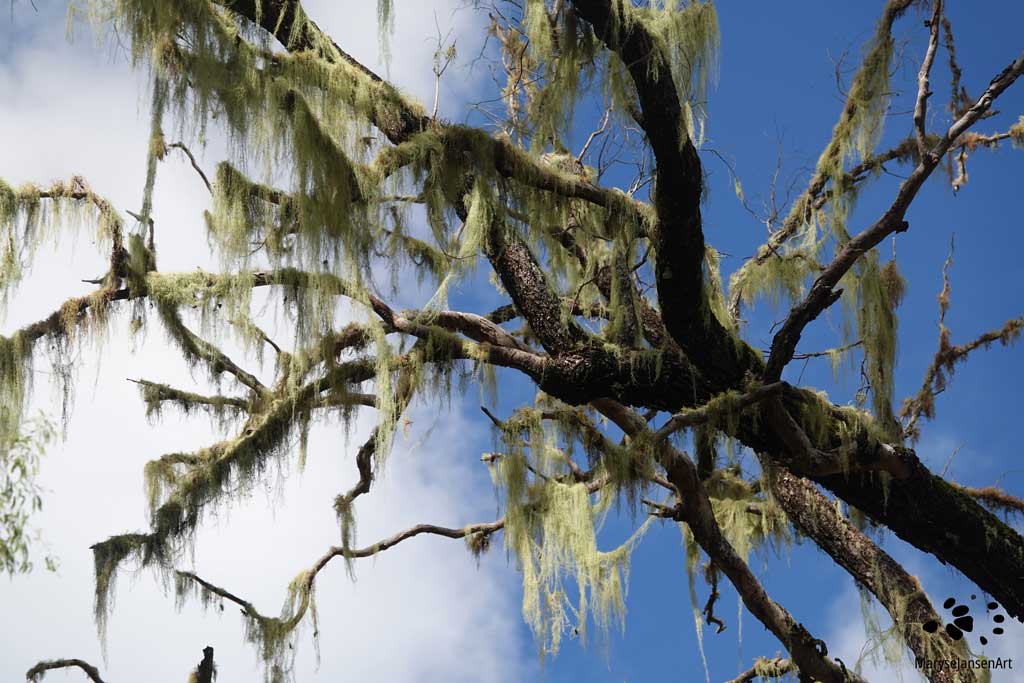Nature Photography with marysejansenart
Usnea lichen indicator species for clean air

Table of Contents
A mysterious fairy-tale forest
A path diverges from the circuit I am walking. As the circuit track is not long and it’s still early, I am tempted to explore. I’m in a lovely open forest with some shrubs and tall grasses in the understorey. It’s a glorious, sunny, mild autumn day and is perfect walking weather – not too hot and not too cold. The birds are singing their little hearts out and insects are buzzing. The tall grass brushes past my legs as I walk on the narrow path. In one of the trees I spot an ‘Old Man’s Beard’, also known as Beard Moss.
I walk on and it becomes clear that this path has not been used for a while as it is quite overgrown in places by the bushes. I keep going though because this place is drawing me in. It’s slow going in places and challenging to work through all the prickly branches, but when I reach an open spot my jaw drops in awe… I feel like I have walked straight into a mysterious fairy-tale forest! The trees here are literally covered in Old Man’s Beard! The sunlight accentuates their light green colour as the long, hanging mosses slowly wave back and forth in the breeze. It is just beautiful!
Old Man’s Beard brings fungi and algae together in a symbiotic relationship
Old Man’s Beard, or Beard Moss belongs to the genus Usnea and it’s not actually a moss but a lichen. Lichen are very interesting plant-like organisms that consist of one or more fungi and algae.
These fungi and algae live in a symbiotic relationship with each other. They form a single body together so we can speak of conjunctive symbiosis. In this case, it is a mutualistic relationship, which means that both species in the symbiosis benefit from each other. Firstly, the algae produce carbohydrates through their photosynthesis. The fungi absorb these in their cells and transform them into a different carbohydrate. Secondly, the algae produce vitamins that the fungi need. In return, the fungi absorb water vapour from the air that the algae benefit from. It’s a very ingenious system!

Bioindicator for clean air
Usnea lichen grow very slowly and can get very old. They can survive periods of drought quite well but they are very sensitive to air pollution. In clean air, they can grow quite long, but in polluted air they stay very small or don’t survive at all. Because they can only grow well in areas with clean air, Usnea lichen can be used as a bioindicator. A bioindicator is a species whose function, population, or status can reveal the qualitative status of the environment. It certainly looks like I am breathing in some very healthy mountain air here in this place!
It is a common misunderstanding that the lichen might be responsible for the loss of leaves and illnesses of their host trees. It’s actually the other way around: the Old Man’s Beard has a preference to grow on sick or dying trees, simply because the lack of a dense canopy gives the algae a better chance at photosynthesis. Therefore the lichen can grow better.
Old Man’s Beard versus Spanish Moss
Do not confuse Usnea lichen with the similar looking Spanish Moss – also often referred to as Beard Moss. This is not a lichen, but an actual moss which is a plant. It’s an epiphytic plant which means it absorbs nutrients and water from the air through it’s own leaves. It is also quite sensitive to air pollution.
I put my attention back to the stunning scene in front of me and grab my camera. These in Old Man’s Beard covered branches and trees are wonderful subjects.
If you are interested in purchasing a print of ‘Old Man’s Beard’ or would like to see what the image looks like on the various merchandise products, please head to my shop. If you’d prefer ‘Gnarly Tree with Old Man’s Beard’, click shop here.
Join me on my walk and marvel at the fairy tale forest in the latest episode of ‘Come for a walk in the Australian Bush’:
For another story about a different type of fairy-tale forest, click here!


